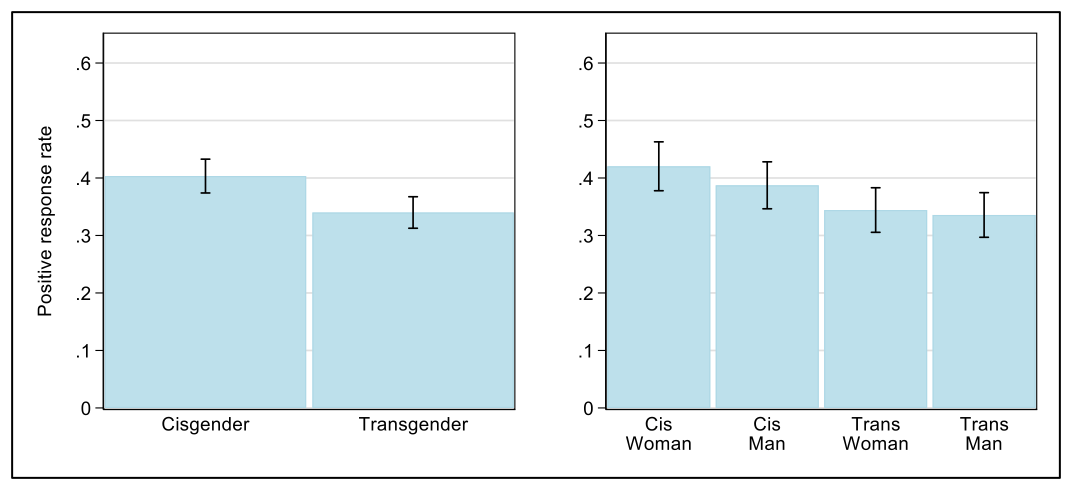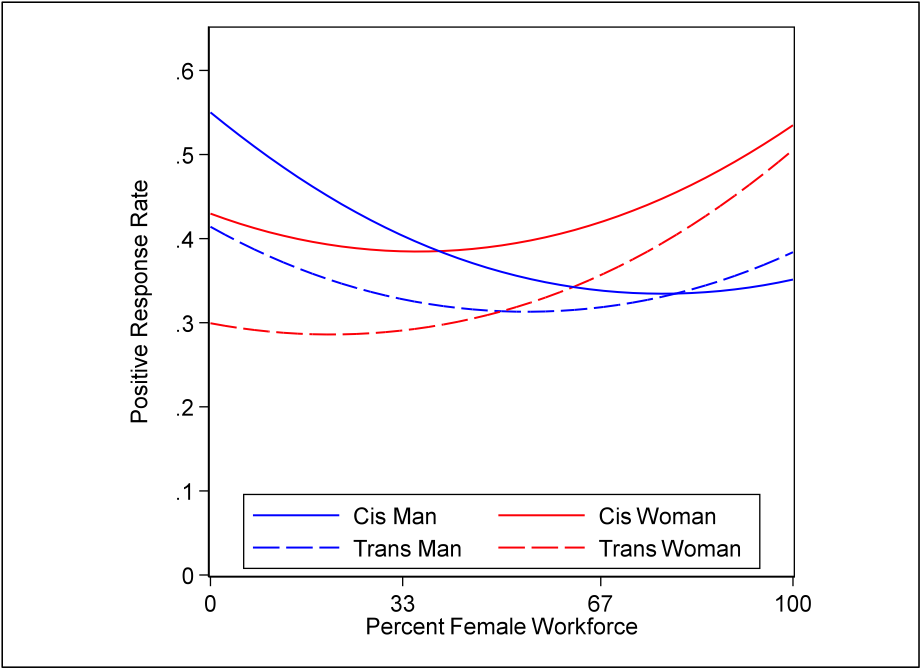
Some may take the statement in the title of this post as completely obvious. It was therefore quite surprising to us that no study had previously attempted a rigorous experimental test of whether transgender applicants face discrimination in the hiring process. Previous studies have instead tended to rely on self-report measures where transgender people report experiencing relatively high rates of discrimination throughout many facets of their everyday life. For example, in a recent EU-wide survey 37% of transgender people said that they have experienced discrimination when looking for work.
However, there is an inherent difficulty in determining the motives behind decisions, which makes self-report measures of discrimination unsatisfactory for proving its existence or extent. For example, a hiring agent may be indiscriminately rude to everyone and anyone, or may have based their behaviour on your belonging to a group which they dislike. As social pressures reduce the prevalence of overt discrimination, it is hard to know which of these motivations lie behind a single interaction and analyses of aggregate trends are needed.
This, along with the fact that transgender people are a growing minority group to whom legal protections were recently extended, provided the impetus for us to conduct an experimental test of their situation in the hiring process. Generally, our experiment verified the experiences of hiring discrimination that transgender people tend to report in surveys. We also showed how discrimination against transgender applicants varies across gendered occupations. The published paper is available here, but in this post I will give a quick summary of our results.
We used a correspondence testing design where 2,224 fictitious applications were sent out to real job openings all over Sweden. This methodology has been used to study discrimination against numerous other groups. For our experiment, transgender identity was randomly assigned to about half of the applications and was not stated explicitly but implied in the personal letter through the applicant having changed their name from a male name to a female name or vice versa. The fictitious applicants also pointed out how disclosing this name change was a necessity, as some of their paperwork, should the hiring process proceed, would be in the old name. The results showed significant differences in the probability for trans- and cis-gender applicants to receive positive responses to their applications.
Figure 1 shows the estimated probability of a callback for each type of applicant in the experiment. As we can see, cisgender applicants received a positive response to about 40% of their job applications whereas transgender applicants only received positive responses to 34% of theirs. These high callback rates at baseline were likely due to our focus on relatively low-skill jobs.
Figure 1. Estimated probability of a call back of applicants

We targeted twelve low-skill jobs in Sweden with different gender ratios. We chose four male-dominated occupations where the share of women was below one third, four female-dominated occupations where the share of women was over two thirds, and four mixed occupations where the share of women was between one and two thirds. The male-dominated occupations were: vehicle mechanic (4% women), forklift operator (6% women) delivery/truck driver (8% women), and warehouse worker (22% women). The female-dominated occupations were: customer service (70% women), cleaner (75% women), childcare (82% women), and enrolled nurse (92% women). Lastly the mixed occupations were: telemarketing (43% women), chef (53% women), waitstaff (59% women), and store clerk (63% women).
In figure 2 we see that when we graphed the response rates for different applicants across occupational gender ratios, some interesting patterns emerged. In the female-dominated occupations we found that women tended to receive a positive response more often than men, regardless of whether the men were cis- or transgender. In male-dominated occupations we instead found that transgender people received fewer callbacks, regardless of whether they were male or female. In figure 2 this can be seen graphically through the distance between dashed and solid lines in male dominated occupations and, in contrast, the distance between blue and red lines in female dominated occupations (in the mixed occupations, there were no significant differences in callback rates).
Figure 2. Response rates for different applicants across occupational gender ratios

Our findings are interesting for a number of reasons. First, as I have already mentioned, no matter how compelling an individual’s experience may be, unless there are overt statements about the employer’s motivations, it will always be difficult to prove hiring discrimination in individual cases because intent is so challenging to establish. Experiments such as ours play an important role in verifying and validating the experiences of individuals affected by discrimination. The results also show that there is still policy work to do to achieve equality of opportunity for this particular group.
Second, our results show the difficulty in establishing on what grounds one has been discriminated against. For example, a transgendered male applicant may be discriminated against based on their transgender identity in male-dominated occupations and based on being male in female-dominated occupations. At least in Sweden, these are two distinct legal bases for discrimination. Our results in this study highlight the difficulty in distinguishing on which basis one has experienced discrimination, a problem that only becomes a bigger issue the more protected groups one belongs to.
Third, we show that even though legal protections have been extended to cover this growing minority group, they still experience discrimination in the Swedish labour market. From an economic perspective, this means that these labour markets may not be making efficient use of available human capital. With such inefficiencies, potential economic gains are never realised, resulting in a loss for all of society not to mention the transgender people directly
♣♣♣
Notes:
- This blog post is based on the author’s paper Hiring Discrimination Against Transgender People: Evidence from a Field Experiment, with Per A.Andersson and AliAhmed, in Labour Economics, Volume 65, August 2020. The paper was presented at the European Economic Association’s Annual Congress, August 2020.
- The post expresses the views of its author(s), not the position of LSE Business Review or the London School of Economics.
- Featured image by geralt, under a Pixabay licence
- When you leave a comment, you’re agreeing to our Comment Policy
 Mark Granberg is a PhD candidate in economics at Linköping University in Sweden. Email: mark.granberg@liu.se
Mark Granberg is a PhD candidate in economics at Linköping University in Sweden. Email: mark.granberg@liu.se






1 Comments